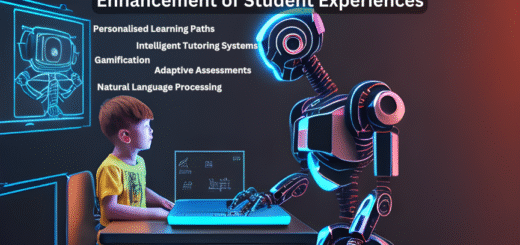AI Tools Every Teacher Should Use in 2025
Introduction
The integration of Artificial Intelligence (AI) in education has revolutionized teaching methodologies, making learning more personalized, efficient, and engaging. For educators, AI tools have become indispensable in simplifying tasks, enhancing student interaction, and providing valuable insights into learning patterns. As we step into 2025, it is essential for teachers to familiarize themselves with the most impactful AI tools that can transform their teaching experience.
Benefits of AI Tools for Teachers
1. Personalized Learning Experiences
AI tools allow teachers to cater to individual student needs by analyzing performance data and creating customized lesson plans. These tools identify strengths and weaknesses, ensuring targeted interventions. For instance, platforms like Smart Sparrow use adaptive learning algorithms to design content tailored to each student’s progress.
2. Time-Saving Automation
By automating tasks such as grading, scheduling, and attendance tracking, AI frees up teachers’ time, enabling them to focus on creative lesson planning and student engagement. Automated grading tools like Gradescope can evaluate hundreds of assignments in minutes, maintaining consistency and accuracy.
3. Enhanced Student Engagement
Interactive AI-powered platforms make learning more dynamic and enjoyable. Tools like gamified quizzes and virtual reality simulations capture students’ attention and improve knowledge retention. For example, platforms like Kahoot! and Quizlet utilize AI to create interactive quizzes that keep students motivated.
4. Data-Driven Insights
AI tools analyze large volumes of data to provide actionable insights. Teachers can better understand student progress, predict outcomes, and implement strategies for improvement. With tools like Learning Analytics by Brightspace, educators can monitor performance trends and address gaps effectively.
Essential AI Tools for Teachers in 2025
1. Intelligent Tutoring Systems (ITS)
Intelligent Tutoring Systems are AI-driven platforms that provide personalized instruction to students. Examples include:
- Knewton: Offers adaptive learning technologies for personalized content delivery.
- Socratic by Google: Assists students with homework by using AI to break down complex problems.
2. Automated Grading Systems
AI tools such as Gradescope and Turnitin simplify grading by evaluating assignments, detecting plagiarism, and providing detailed feedback. These systems ensure fairness and consistency in assessment, saving countless hours of manual effort.
3. Virtual Classroom Platforms
With tools like Google Classroom and Microsoft Teams, teachers can manage virtual classrooms effectively. These platforms integrate AI to monitor student participation, identify areas needing attention, and facilitate seamless communication.
4. AI-Powered Content Creation
Tools like Canva for Education and EdPuzzle enable teachers to design engaging multimedia content. AI algorithms suggest templates, graphics, and interactive elements tailored to specific subjects, allowing educators to present concepts creatively.
5. Language Learning Tools
For language educators, AI-powered applications such as Duolingo for Schools and Rosetta Stone offer advanced speech recognition and adaptive learning techniques to enhance language acquisition. These tools are particularly useful in multilingual classrooms.
6. Classroom Management Tools
AI tools like Classcraft gamify classroom management, fostering a collaborative and disciplined learning environment. Teachers can monitor behavior, reward achievements, and maintain a positive atmosphere, making classroom management less stressful and more engaging.
7. Learning Analytics Platforms
Platforms like Brightspace Insights and PowerSchool use AI to track student performance metrics, enabling data-driven decisions to improve learning outcomes. They provide real-time dashboards that highlight areas requiring intervention.
8. Virtual Reality (VR) and Augmented Reality (AR)
AI-enhanced VR and AR tools, such as Nearpod VR and Merge EDU, provide immersive learning experiences, making subjects like history and science more engaging and interactive. These technologies bring abstract concepts to life, enhancing comprehension and retention.
9. Speech-to-Text and Translation Tools
AI-driven tools like Otter.ai and Microsoft Translator facilitate accessibility and inclusivity in classrooms. They transcribe lectures in real-time, assist students with disabilities, and enable communication in multilingual environments.
10. Collaborative Learning Platforms
Tools like Padlet and Miro use AI to support collaborative learning. These platforms allow students to brainstorm, share ideas, and work on projects together, fostering teamwork and critical thinking.
Challenges in Adopting AI Tools
1. Cost and Accessibility
High implementation costs can limit access to AI tools, especially in underfunded schools. Ensuring equitable distribution of technology remains a challenge. Governments and organizations must invest in infrastructure and subsidize tools for marginalized communities.
2. Teacher Training
Effective use of AI tools requires proper training. Teachers may face difficulties adapting to new technologies without adequate support. Professional development programs and workshops are essential to bridge this gap.
3. Privacy Concerns
AI tools collect and analyze student data, raising concerns about data privacy and security. Clear policies are needed to protect sensitive information. Schools must ensure compliance with regulations like GDPR and FERPA.
4. Overdependence on Technology
Relying heavily on AI tools may hinder the development of traditional teaching skills and reduce human interaction in classrooms. Striking a balance between AI and human expertise is crucial to maintain the essence of teaching.
5. Resistance to Change
Some educators may resist adopting AI tools due to fear of the unknown or skepticism about their effectiveness. Awareness campaigns and success stories can help overcome this resistance and encourage wider acceptance.
The Future of AI in Education
1. Real-Time Feedback
Advanced AI systems will offer instant feedback to students, accelerating their learning process. Tools like adaptive learning platforms will continuously evolve to provide personalized insights and resources.
2. Increased Collaboration
AI will facilitate better communication between teachers, students, and parents through intelligent systems. Platforms will integrate features like predictive analytics and behavioral tracking to ensure holistic student development.
3. Global Classroom Access
AI tools will connect classrooms worldwide, promoting cross-cultural learning experiences. Students will collaborate with peers from different countries, fostering diversity and global citizenship.
4. Lifelong Learning
AI will support lifelong learning by providing tailored resources for educators and students. From microlearning modules to AI-powered mentors, the future of education will prioritize continuous skill enhancement.
5. Integration of Emerging Technologies
AI will integrate with emerging technologies like blockchain for secure certification, IoT for smart classrooms, and quantum computing for enhanced computational capabilities, transforming the educational landscape.
Conclusion
AI tools have become indispensable in modern education, providing teachers with innovative ways to enhance learning experiences. From personalized instruction to immersive VR lessons, these tools empower educators to create more engaging and effective classrooms. However, addressing challenges such as cost, training, and privacy is crucial for widespread adoption. By embracing AI thoughtfully, teachers can shape a future where technology and human expertise work hand in hand to deliver quality education.
Achieving this balance requires collaboration among educators, policymakers, and technology providers. With the right strategies, AI can revolutionize education, making it more inclusive, efficient, and impactful for future generations.


